2012 McLaren 12C
Ben Barry was present at the McLaren 12C’s launch. 15 years on, he revisits this game-changing supercar and discovers F1 performance for rather less than £17m.
Photography Jordan Butters
McLAREN’S GAME CHANGER — F1 PERFORMANCE FOR SALOON CAR MONEY: WHY YOU NEED A 12C
ALL THE MCLARENS SINCE 2012
Plus why the analogue supercar market is booming
How McLaren changed the supercar game – and why you will want one now
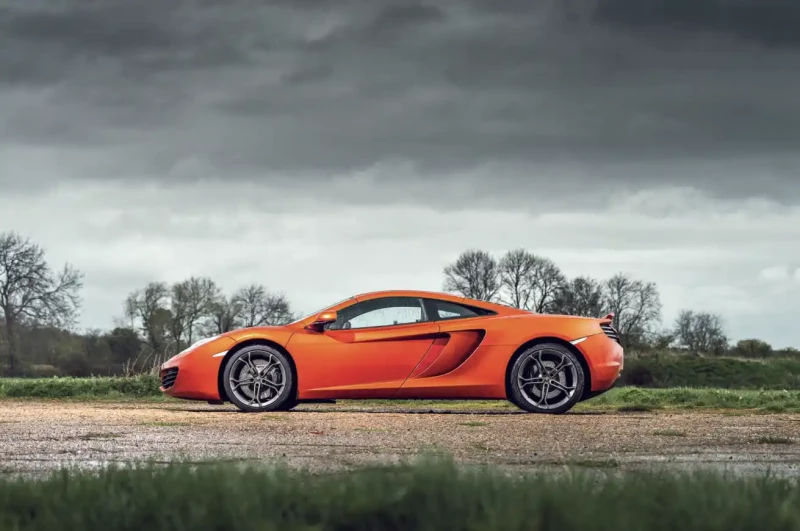
The first time I sat in a McLaren MP4-12C, it was 2009 and I was in a preview room deep inside the McLaren Technology Centre, with Ron Dennis looking back at me through the windscreen. The man who’d overseen most of McLaren’s eight drivers’ championships and 12 constructors’ titles, not to mention the McLaren F1 road car, was intently following my prompts until his finger lay exactly on the highest point of the passenger-side front wing.
‘Right a bit… STOP! That’s the centre-line of the wheel,’ announced McLaren’s executive chairman proudly, once I’d successfully directed him to the summit. ‘Optical cueing, those things against which the driver determines his timing. You can position this car precisely on a race circuit or in a car park.’
Now, 15 years on, those same peaks and the low scuttle are helping me guide a 12C (the MP4 prefix was quickly dropped) over this fast and flowing landscape with total confidence, the view like that from a low-flying F14 and the handling to match as tarmac ribbons ahead of me. I squeeze the throttle and boost from twin turbochargers hauls me out from the next 30mph zone like an undertow dragging me relentlessly out to sea, with every throttle-lift and gearshift triggering a whipcrack release of pent-up energy, every determined squeeze on the brake popping up the Airbrake rear spoiler behind me.
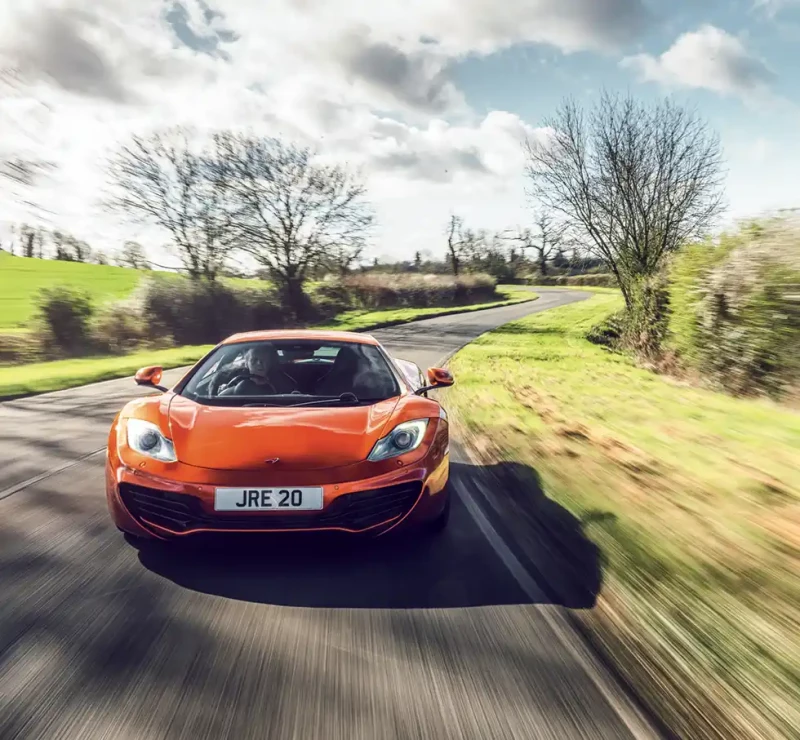
Even the boss hadn’t driven a 12C when we spoke in 2009, deferring to his development team, but he’d covered 1000 miles in his own F1 road car the weekend before and still daily-drove a Mercedes-Benz SL65 – handy reference points for the performance and comfort he hoped would define the 12C.
Today the performance Dennis promised remains explosive – 616bhp is neck-and-neck with an F1’s – and the damping is remarkably supple over this sweeping cross-country route. Everything in owner Stuart Templeton’s exceptional 13,000-mile 12C is exactly the same as I remember from McLaren’s design studio, not only the remarkable visibility, but the Volcano Orange launch colour and seats with leather bolsters and centres in honeycomb ‘technical’ fabric, too.
The big difference boils down to price. On its launch in 2011, a 12C cost £168,500 before options. Now there’s no shortage of nicely spec’d low-mileage examples for £65,000 and specialist help to make bills more palatable. No mid-engined supercar provides comparable bang-per-buck (Audi R8 V10s can be had for less but are 100bhp off the pace), and only the underwhelming Alfa 4C offers carbonfibre construction for less.
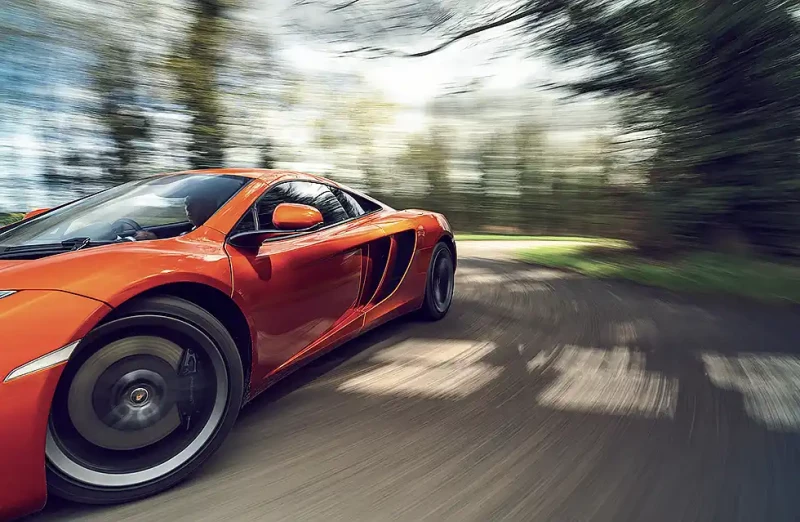
The 12C was that rare thing in the automotive industry: a complete clean-sheet design with literally zero carry-over components. No excuse for not getting that driving position spot-on. Former McLaren chief test driver Chris Goodwin was key to that, an experienced hand who’d first raced the F1 GTR in 1997 and was still regularly working with McLaren when Dennis asked for a meeting.
‘Ron was pretty brutal and said racing was a waste of time, that no-one cared and I needed to come and work for him!’ laughs Goodwin. ‘He said we were going to try and take on Ferrari. That was around 2000.’ The Mercedes-McLaren SLR joint project was the warm-up act and then – following a pause rather than the originally intended overlap between the two cars – McLaren’s attention turned to the 12C, with a team short on road-car experience but high on ambition and brain cells.
Mark Vinnels was on board as product director and had worked at Lotus, but technical director Dick Glover was a former F1 man and ‘recruited a bunch of super-clever guys from uni’. Building a car from the driver outwards was all part of the blue-sky thinking.
‘A good deal of work was done in advance in terms of a concept, but the first thing I did was sit in the styling studio in a wooden box, and we worked on sightlines and A-pillar positions, thinking about where the driver should sit and what he wanted to see,’ recalls Goodwin.
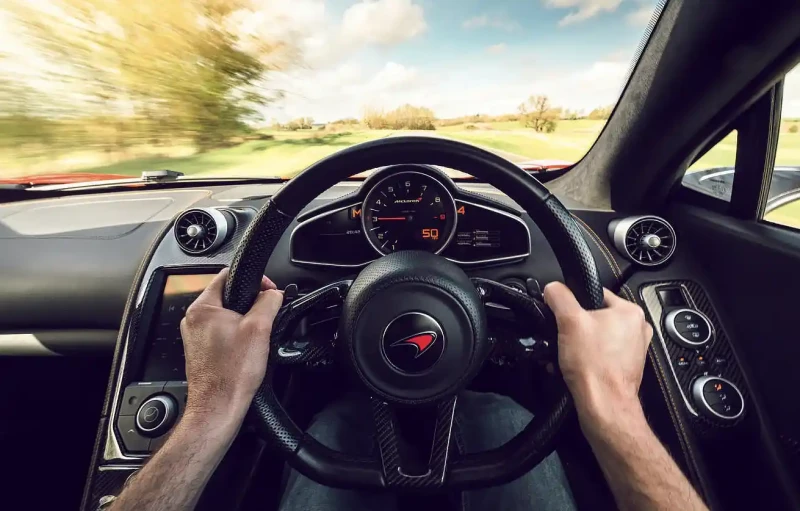
A carbonfibre tub was always planned for its strength, stiffness and light weight, and because McLaren had pioneered the material in Formula 1 and used it soon after on the F1 road car. But series production demanded an alternative approach to the 4000 hours consumed by the F1’s pre-preg construction, and so McLaren turned to resin transfer moulding. Now a tub could be knocked out every four hours.
Called MonoCell, the new tub weighed just 80kg, which along with a mix of SMC and aluminium exterior panels contributed to the 12C’s dry weight of just 1336kg – 44kg less than Ferrari quoted for the aluminium (and less powerful, at 562bhp/398lb ft) 458. Aluminium subframes front and rear provided attachment points for the all-round double-wishbone suspension and mid-mounted engine.
Before the first tub, though, a Noble with modified suspension pick-up points and a chassis beefed up to comparable stiffness was used as an early test mule, while McLaren’s expertise in simulation also carried over from Formula 1. ‘We were using Top Gear’s Dunsfold test track, which was an awesome place for us,’ enthuses Goodwin. ‘We very quickly realised the suspension wasn’t great but McLaren was way ahead of the game with driver-in-the-loop simulators, so we made a significant change to the geometry based on simulator work – after that, entry stability and the speed you could carry into a corner was unreal.’
While a carbonfibre chassis was non-negotiable, debate dragged on over whether the engine should be naturally aspirated – the norm back then – or turbocharged. Goodwin favoured natural aspiration because the turbo Lotus GT1 car he raced never finished, while the McLaren F1 always did and its V12 was, as he astutely observes, ‘mega’.
‘Thankfully that was one of the few bits of my feedback that didn’t get listened to because we had some amazing performance out of the turbo engines,’ says Goodwin, ‘but that made it more challenging to install and to develop reliably.’
Initially fitted in an Ultima GTR engine development mule, the result was a 3.8-litre, flat-plane-crank V8 with twin turbochargers, designed by Ricardo and dubbed M838T. Power was initially 592bhp, rising to 616bhp soon after as part of a package of free upgrades to remedy driveability. Torque was 443lb ft either way.
Those very early cars were shunty when you backed in and out of the throttle, where Stuart’s updated car is much smoother and more progressive, the boost better finessed. But one thing his car doesn’t have is revised door buttons – a quick fix for a design that bowed to Dennis’s aversion to clutter by banishing physical handles.
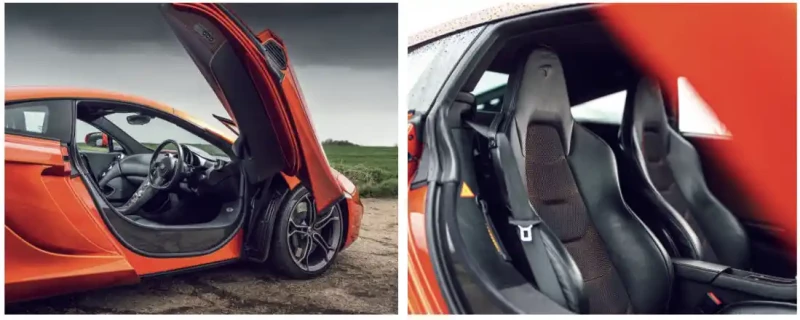
Often criticised for appearing anonymous in period, today the Frank Stephenson design (officially Stephenson ‘finalised’ the design, after joining McLaren in 2008) looks striking precisely because of its understated if muscular proportions, restrained detailing, and those notorious ‘handles’ activated by gliding a hand under the ledge on the doorskin – the trick is to do it with a flourish, like a magician running a hand under a levitating assistant.
Then the dihedral door swings up, revealing a chunk of carbonfibre sill and – beyond – a narrow spine of a centre console that helps position two occupants closer to the centre-point of the car (even the infotainment screen is portrait oriented). It’s something of a limbo dance to climb inside, but the driving position is near-perfection, with pedals that very much invite left-foot braking, and comfortable, supportive seats that drop your backside way below your knees but could perhaps go a fraction lower (maybe this car’s electric adjustment doesn’t help in that respect). It’s far from sparse, but the vibe is function and focus in here. No drivemode buttons sully this steering wheel, a rev-counter redlined at 8500rpm dominates the dash like an all-seeing eye, while the Active Dynamics Panel on the centre console allows you to mix-and-match three flavours each of powertrain and handling modes like a fighter pilot might run through a pre-flight check.
Press the starter button and the M838T is a match for the no-frills character, with a gruff growl of an idle that’s more purposeful than charming. Easy thing to mooch about in, though, with good driveability around town and the Graziano transmission proving smooth from even tentative hill starts. It’s just that, at first, nothing feels particularly direct. The brake pedal is very soft (intentional, says Goodwin, to give good modulation on track, with mushy initial response the compromise) and even gearshifts are a little soft, an impression not helped by interconnected paddles that feel a little baggy. Neither is the low-speed ride as resolved as I remember, with some bobble and the occasional hollow thunk transmitted through the carbonfibre structure.
Rather, it’s the inherently spot-on driving position and delicate steering that first help me bond with the 12C, the latter being a hydraulically assisted set-up that’s calmer than a Ferrari 458’s flighty rack, and significantly more talkative. But to really click with the 12C, you must add speed and plenty of it. Only then does the missing cohesion and drama filter through to the driving experience. And even though nothing much happens below 3000rpm, there’s response to throttle inputs and the sense of a very big handle being furiously cranked in the background, and by the mid-to-high threes your right foot is dipping into a large swell of performance. It’s a slightly ominous feeling: things are moving quickly now, and by the low fours it’s as though the road is being sucked under the plunging neckline of a windscreen and into the induction plenums.
Best look ahead, not down at a dial, because the 12C’s turbos are really lit, and there’s a frenzied rush until the full 616bhp is served up at 7500bhp, with generous spare change beyond that. This is not like the scream of a V8 Ferrari, rather a deeper, darker flavour of V8, more industrial in nature if still compelling in its own way, with a reach to this vast performance that’s hard to repeatedly tap on the road. It’s at these heights, with its fusion of massive performance, response and the reward for chasing peak revs, that the M838T really elevates itself above the forced-induction norm. Even the initially dozy gearshifts snap awake, engaging near-instantaneously to land you bang in the meat of that powerband all over again.
Thankfully the chassis does a solid job of transmitting all that shove cleanly to the ground, too, and even as the single pantograph wiper arm sweeps a deluge from the McLaren’s screen, there’s far more traction than you’d credit from the 305-section rear Pirellis, and less to be feared when they do finally relinquish grip.
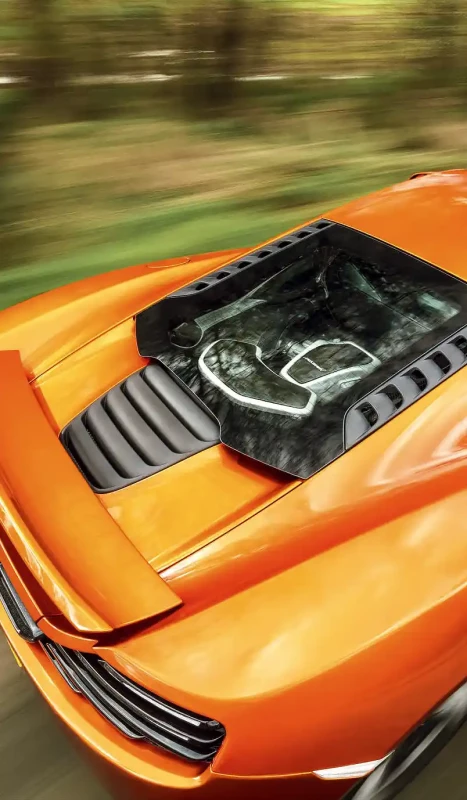
Credit some of that to the good old-fashioned geometry and pick-up points Goodwin mentioned, but he also remembers one big handling breakthrough coming at the wheel of a Subaru – after that, Proactive Chassis Control was a no-brainer. ‘Very early on we did a tech assessment with a kinetic system [from Tenneco] that used hydraulically interlinked dampers,’ says Goodwin. ‘We tried it on a Subaru fitted with the system, and one without, and it was amazing. It provided roll control without any anti-roll bars, so it improved comfort, and the grip and performance you’d find on the way to the apex were just amazing.
‘You really needed the adaptive damping to make it feel a little more natural, though, which we got better at in the later cars, but to this day, that’s still one of the secrets of McLaren’s ride and handling success.’ Brake Steer was another breakthrough, a system that replaces the weight and cost of a limited-slip differential in the 12C with technology McLaren pioneered in Formula 1 and which was subsequently banned for its unfair advantage. In the 12C, Brake Steer works automatically (rather than via an additional pedal) to prevent the inside wheel from spinning while pushing more torque to the outside wheel for a torque-vectoring effect, helping drive the car into the turn.
Early testing was not high-tech. ‘We cobbled-up a motorcycle brake lever onto the back of the Noble’s steering wheel, made it active on one of the rear calipers and went to Dunsfold to log where I could use it to best advantage, then we’d switch it to the other side and repeat,’ Goodwin explains. ‘That turned into a start point for some control software.’
Toss the 12C into a corner and it all comes together, lungeing for the apex while staying spookily flat and untroubled by mid-corner bumps. It just glides. But neither is this some humourless laser-guided weapon – even with stability control very much engaged, a quick bung of steering and lift-off throttle gets the rear arcing round just a smidge, with the rear tyres still very much working with and gripping against the surface. It’s the sort of predictable reactivity racers crave.
Overall, though, contemporary testers rated the 12C a fraction behind the Ferrari 458, myself included. Good as the McLaren was, the Ferrari had more fizz, a more beguiling balance of grip and tippy-toes playfulness, and served up more entertainment than even the 12C could muster.
Goodwin acknowledges mistakes were made. After working on the McLaren 720S, he moved from McLaren to work on the Aston Martin Valkyrie in 2017 and then ‘retired’, though he continues to own a race team and manages a ‘huge car world for a wealthy car guy in America’. ‘Today my perspective is totally different,’ he reflects. ‘I’m super-proud of what we achieved but we were myopic, inexperienced road-car people and having a view of who the competition were and what customers wanted was definitely not our strength at that time. Feedback from the media and customers quickly fed into the 650S, 675LT and 720S.’ Goodwin notes that managing the car collection has given him an appreciation for enjoying cars as they were in-period, but clearly that development driver is still in there, agitating for improvement.
‘The 12C was just really short on development time, so arguably the 650S was what the 12C should’ve been from the start, and then the 675LT also benefited from much more experience,’ he sums up. ‘The thing is, the 675LT is just a different flavour of a car, the hardware is the same, it’s just tuning with a more specific target in mind – spring rate, spring balance, damping, a fraction more downforce, that’s it. So my dream would actually be to take a 12C, then re-tune it. There’s a decade of all that knowledge and feel and understanding that you could fire into that.’ More power and less weight, too.
Given Longtail models currently hover in the £190-260k ballpark to a 12C’s £65-95k, I suggest Goodwin could have a compelling business plan on his hands. He demurs but who knows… maybe Ron Dennis could persuade Goodwin to quit the day job all over again.
TECHNICAL DATA 2012 McLaren 12C
- Engine 3799cc 32v V8, DOHC per bank, twin-turbocharged, fuel injection
- Max Power 616bhp @ 7500rpm
- Max Torque 443lb ft @ 3000-7000rpm
- Transmission Seven-speed dual-clutch automated manual, rear-wheel drive
- Steering Rack and pinion, power-assisted
- Suspension Front and rear: double wishbones, coil springs, hydraulically interlinked adaptive damping
- Brakes Discs
- Weight 1336kg (dry)
- Top speed 207mph
- Acceleration 0-62mph 3.1sec
RUNNING ONE: THE EXPERT VIEW
Thorney Motorsport is the biggest independent specialist
Currently there are more than 700 McLarens on the Thorney books, making it the biggest buyer of McLaren parts outside the UK dealer network, with an annual spend of £500k.
Typically Thorney deals with 12C geometry that’s easily knocked out of alignment, or wear items such as upper arms, lower arms and Z-bar links. There are, of course, horror stories, including gearbox failure related to input shaft issues. McLaren replaces the gearbox for £27k, but Thorney developed its own driveshaft seals, input seals and bearings and, says John Thorney, ‘We can now repair any gearbox around the world for £7500.’ Cam phasers are prone to wearing, especially if engines are revved hard before fluids are warmed, or run low on oil. That’s a top-end rebuild for £10k.
So, yes, 12C ownership can be ruinous if things go really wrong, of course it can. But Thorney charges £125 per hour plus VAT, and servicing should average out at around £1500 annually over three years – circa £500 for a small service, £2500 for biggies. Thorney also offers warranties for £2850 annually to isolate owners from unexpected shocks, and currently covers 350 cars.
Visit thorneymotorsport.co.uk.
THE OWNERSHIP PROSPECT
Stuart Templeton downloads his experiences
‘I’ve always had a passion for engineering – I remember watching my dad strip, repair and tune everything from early Astons to rally-prepping a 2.7RS Lightweight. Then a friend ordered a very early 12C from McLaren Birmingham and I was lucky to join him at the open evening. There was a complete 12C on display, but also a rolling chassis with all exposed running gear and, again, I just loved the engineering.
‘I’ve owned everything from an M3 to a TVR Chimaera, Nissan 300ZX and various hot hatches and Porsches over the years, but long had the 12C as a life goal. Then this car came up after I’d been watching 12C prices fall for months. It had been stored in a collection and was a one-owner model in the right colour with 9000 miles when I bought it, plus a carbon diffuser, carbonbacked seats, carbon interior fixtures and carbon engine bay panels. It’s also got the Stealth alloys. The previous owner must have ticked every option box! It also had a full Birmingham McLaren history, if with a few missing stamps due to storage and Covid.
‘Once I’d bought it, I drove it to Birmingham for a thorough inspection and full service, which included all the missing previous service stamps and a new water pump. It has been a little silly on prices for some maintenance items, but it has also been faultless and is such a rewarding ownership experience.’
Below, right and bottom right Rear spoiler also acts as an air brake; superb driving position allows you to place the car perfectly; even getting in and out is a theatrical occasion.
Below and right Dart-like yet muscular profile has aged beautifully, perhaps thanks to its ineffable understatement; twin-turbo V8 offers devastating acceleration.
‘BUILDING A CAR FROM THE DRIVER OUTWARDS WAS ALL PART OF THE BLUE-SKY THINKING’
McLaren may have been swathed in some negative headlines and unwelcome speculation for quite a few years now, but it’s easy to forget that there was a time not so long ago when the company was not only unimpeachable but untouchable.
Its utter dominance of Formula 1 may have drawn to a close in 1990, but there were still spurts of brilliance, seemingly coming towards the end of each decade. And even when it wasn’t winning, McLaren was still always a contender, still a very big fish in the paddock. Then, after the turn of the millennium, design – especially British design – suddenly became a big deal, as the world’s purchasing ethos shifted from people only wanting everything as cheaply as possible to swathes of people being prepared to pay a premium for excellence built on flawless or innovative engineering. Especially if it was blue-blood British. Just ask James Dyson.
The time was ripe for McLaren to launch itself into road cars, the company image, the sterile headquarters in Woking (from which my rotten old nail was once evicted on aesthetic grounds, but that’s another story) all suggesting a laboratory from which only purity and genius could emerge.
Of course, there had been McLaren road cars before, but this was a whole different ballgame to the one-off M6GT that Bruce McLaren himself drove around Woking, or the F1, which will forever remain as much a high-volume science experiment as a low-volume car.
The acute singularity of purpose of McLaren’s previous road cars meant that, really, the MP4-12C was its first real ground-up production car, a high-performance supercar with its own singular purpose: to give a bloody nose to Ferrari. And it did. As you always knew it would, with Ron Dennis at the helm.
Not only that, though, the MP4-12C (or 12C as virtually everyone would have it) was the strategic foundation for everything that has come since, McLaren seamlessly melding its rich heritage with cutting-edge technology… and so much pace. Whatever McLaren’s current woes, the 12C was a high watermark for a remarkable company at the height of its powers. I’m not saying everything has gone downhill since, but even today the 12C is still the one I’d want, not just for what it can do, but also the enormity of what it represents.


